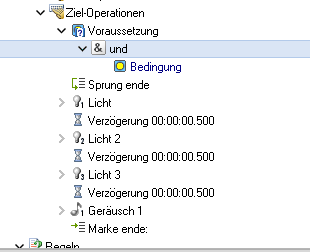Nachfolgezugfahrten und Lokfunktionen/en: Unterschied zwischen den Versionen
Uslex (Diskussion | Beiträge) Die Seite wurde neu angelegt: „1) train journey sequence“ |
Übernehme Bearbeitung einer neuen Version der Quellseite |
||
| (8 dazwischenliegende Versionen von 2 Benutzern werden nicht angezeigt) | |||
| Zeile 1: | Zeile 1: | ||
<languages/> | <languages/> | ||
{{ | {{TC91011g}} | ||
__NOTOC__ | __NOTOC__ | ||
<span id="Nachfolgezugfahrten"></span> | <span id="Nachfolgezugfahrten"></span> | ||
| Zeile 19: | Zeile 19: | ||
1) train journey sequence | 1) train journey sequence | ||
the locomotive functions are entered into the sequence at the start and end | |||
the sequence only consists of this train journey, which has itself as the successor | |||
the switch is entered into the train journey as a condition | |||
if this switch is on, the sequence runs endlessly; switch off, the sequence comes to an end and the locomotive functions are switched off | |||
2) conditional macro | |||
2) | |||
the locomotive functions are entered into the train journey in the form of two macros | |||
the macro for switching off the locomotive functions receives the switch as a condition | |||
the train journey has itself as the successor and the switch as a condition | |||
3) switch query in target operation | |||
3) | |||
the current target operations are extended with a prerequisite and tokens | |||
Attachment: | |||
: | : | ||
[[Datei:Zieloperation.png|310px]] | [[Datei:Zieloperation.png|310px]] | ||
:''Fig: Macro target operation'' | |||
:'' | |||
4) Query whether the train is moving or standing | |||
4) | |||
Similar to 3), you can use a variable to query whether the train is moving or standing at the end of the train journey. However, this has the disadvantage that if it is standing for operational reasons, even though the train journey is active, the train also carries out the operations. | |||
== Weblinks == | == Weblinks == | ||
*Source: [https://www.freiwald.com/forum/viewtopic.php?p=271509#p271509 Forum] | |||
* | *TC-wiki: [[Special:MyLanguage/Zugfahrt mehrfach verwenden|Use train journey multiple times]] | ||
*TC-wiki: [[Special:MyLanguage/Zugfahrt mehrfach verwenden| | *TC-wiki: [[Special:MyLanguage/Lokfunktionen bei Zugfahrt starten|Start locomotive functions when the train is moving]] | ||
*TC-wiki: [[Special:MyLanguage/Lokfunktionen bei Zugfahrt starten| | |||
:-- [[Special:MyLanguage/Benutzer:Uslex|Uslex]] ([[Benutzer Diskussion:Uslex|Diskussion]]) 21:39, 30. Dez. 2024 (CET) | :-- [[Special:MyLanguage/Benutzer:Uslex|Uslex]] ([[Benutzer Diskussion:Uslex|Diskussion]]) 21:39, 30. Dez. 2024 (CET) | ||
:bearbeitet: DeepPurple 08:16, 9. Jan. 2025 | |||
[[Kategorie: Software{{#translation:}}]] | [[Kategorie: Software{{#translation:}}]] | ||
Aktuelle Version vom 12. November 2025, 08:09 Uhr
Subsequent train journeys
Light is turned off
At the beginning of the train journey, locomotive functions such as sound and light start. These are switched off again at the end of the train journey and should start again at the beginning of the next journey.
Unfortunately, that only happens sometimes. Sometimes the light goes on during the second round of the train, sometimes the sound, sometimes nothing at all, sometimes everything...
Locomotive functions without stopping
Silvio Richter writes in the forum: During yesterday's meeting we developed several strategies on how to implement it without the train having to stop:
1) train journey sequence
the locomotive functions are entered into the sequence at the start and end the sequence only consists of this train journey, which has itself as the successor the switch is entered into the train journey as a condition if this switch is on, the sequence runs endlessly; switch off, the sequence comes to an end and the locomotive functions are switched off
2) conditional macro
the locomotive functions are entered into the train journey in the form of two macros the macro for switching off the locomotive functions receives the switch as a condition the train journey has itself as the successor and the switch as a condition
3) switch query in target operation
the current target operations are extended with a prerequisite and tokens Attachment:
- Fig: Macro target operation
4) Query whether the train is moving or standing
Similar to 3), you can use a variable to query whether the train is moving or standing at the end of the train journey. However, this has the disadvantage that if it is standing for operational reasons, even though the train journey is active, the train also carries out the operations.
Weblinks
- Source: Forum
- TC-wiki: Use train journey multiple times
- TC-wiki: Start locomotive functions when the train is moving
- -- Uslex (Diskussion) 21:39, 30. Dez. 2024 (CET)
- bearbeitet: DeepPurple 08:16, 9. Jan. 2025

